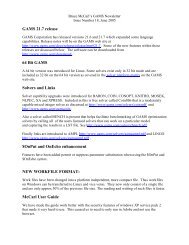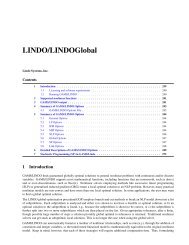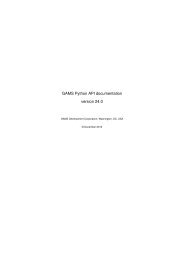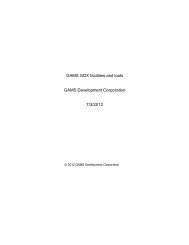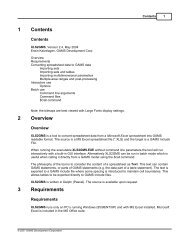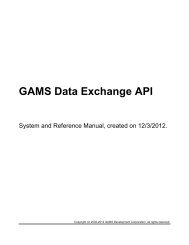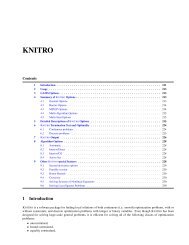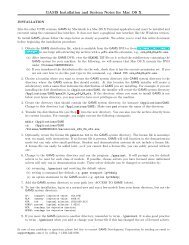Economic Equilibrium Modeling with GAMS
Economic Equilibrium Modeling with GAMS
Economic Equilibrium Modeling with GAMS
Create successful ePaper yourself
Turn your PDF publications into a flip-book with our unique Google optimized e-Paper software.
2<br />
1. An Overview<br />
This document describes a mathematical programming system for general equilibrium<br />
analysis named MPSGE which operates as a subsystem to the mathematical programming<br />
language <strong>GAMS</strong>. MPSGE is a library of function and Jacobian evaluation routines which<br />
facilitates the formulation and analysis of AGE models. MPSGE simpli es the modelling<br />
process and makes AGE modelling accessible to any economist who is interested in the<br />
application of these models. In addition to solving speci c modelling problems, the system<br />
serves a didactic role as a structured framework in which to think about general equilibrium<br />
systems.<br />
MPSGE separates the tasks of model formulation and model solution, thereby freeing<br />
model builders from the tedious task of writing model-speci c function evaluation subroutines.<br />
All features of a particular model are communicated to <strong>GAMS</strong>/MPSGE through a<br />
tabular input format. To use MPSGE, a user must learn the syntax and conventions of<br />
this model de nition language.<br />
The present paper is intended for students who have completed two semesters of study in<br />
microeconomics. The purpose of this presentation is to give students a practical perspective<br />
on microeconomic theory. The diligent student who works through all of the examples<br />
provided here should be capable of building small models \from scratch" to illustrate<br />
basic theory. This is a rst step to acquiring a set of useable tools for applied work.<br />
The remainder of this paper is organized as follows. Section 2 provides practical tips on<br />
how to get started <strong>with</strong> <strong>GAMS</strong>/MPSGE. Section 3 reviews basic ideas from the theory of<br />
the consumer. Section 4 introduces the modelling framework <strong>with</strong> three models illustrating<br />
the representation of consumer demand <strong>with</strong>in the MPSGE language. Section 5 reviews<br />
the pure exchange model, and Section 5 presents two MPSGE models of exchange. Each<br />
of the model-oriented sections present exercises based on the models which give students<br />
a chance to work through the material on their own. Section 6 provides solutions to<br />
exercises from this paper. Additional introductory examples for self-study can be found in<br />
Jim Markusen's library of MPSGE examples, as well as in the <strong>GAMS</strong> model library (look<br />
for models <strong>with</strong> names ending in \MGE").<br />
The level of presentation and diagrammatic exposition adopted here is based on Hal<br />
Varian's undergraduate microeconomics textbook ( Intermediate Microeconomics: A Modern<br />
Approach, Third Edition, W. W. Norton & Company, Inc., 1993).<br />
The ultimate objective of this piece is to remind students of some theory which they<br />
have already seen and illustrate how these ideas can be used to build numerical models<br />
using <strong>GAMS</strong> <strong>with</strong> MPSGE. It is not my intention to provide a graduate level presentation<br />
of this material. So far as possible, I have avoided calculus and even algebra. The objective<br />
here is to demonstrate that what matters are economic ideas. With the proper tools, it is<br />
possible to do concrete economic modeling <strong>with</strong>out a lot of mathematical formalism.<br />
2. Getting Started<br />
(i) In order to use <strong>GAMS</strong>/MPSGE, you need to know how to create and edit text les.<br />
There are several methods for doing this. One approach is to use NOTEPAD, the standard<br />
text editor under Windows 95. It is also possible to use a text processor such as Microsoft<br />
Word as a text editor. If you take this approach, you will need to remember to always save<br />
the edited le in a text format. A nal approach, one which I suggest to graduate students



